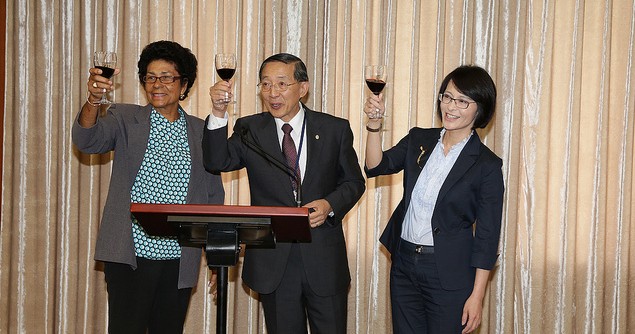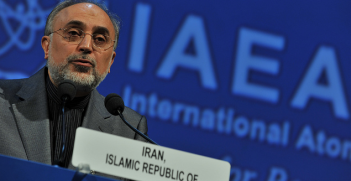Taiwan-Australia Relations: Good Links between Two Democratic Asia-Pacific Middle Powers

As Taiwan expands its diplomatic networks throughout the region, Professor Bruce Jacobs reports on growing Australia-Taiwan ties and the prospect for stronger beneficial relations in the future.
Taiwan’s foreign relations with the major states have essentially normalized. Even though these states all maintain official “one China” policies, they also have a de facto“one China, one Taiwan” policy with substantial “representative offices” (i.e. embassies) in Taipei while Taiwan has substantial offices in their own countries. The overseas foreign affairs representatives in Taiwan are now all normal foreign service officers and enjoy the same rights of diplomats including diplomatic immunity, use of the diplomatic “bag”, and tax privileges. Taiwan’s foreign affairs officials abroad also have similar privileges. In other words, most of the world’s important states now treat Taiwan as a “middle power” in East Asia that has democratic politics, a population of 23 million people, a developed economy, considerable trade, and substantial military forces.
Australia very much fits this pattern. The first two Australian representatives in the upgraded Australian office in Taipei, Colin Heseltine and Sam Gerovich, were previously deputy heads of mission in Australia’s Beijing embassy. This original pattern was broken with the appointment in 2001 of Frances Adamson (who is now Australia’s ambassador in Beijing). Since then, none of Australia’s representatives in Taiwan has come directly from Beijing. Kevin Magee, who has just left Taiwan, had previously served as Australia’s ambassador to Saudi Arabia. He clearly desired Taipei as his next post—an indication in Australia’s foreign service of the importance vested in the Taipei office. Under Mr Magee, Australia changed the name of its Taipei post from the Australian Commerce and Industry Office (ACIO) to the Australian Office (AO).
Similarly, Taiwan has sent senior people to Australia as both “ambassadors ” in Canberra and “consuls general” in Melbourne, Sydney and Brisbane. For example, the last three Taiwan ambassadors to Australia have been Timothy Yang (楊進添), who later served as ambassador to Indonesia as well as Minister of Foreign Affairs and who currently is Secretary-General of the Presidential Office; Gary Lin (林松煥,)who later became Secretary-General of the Ministry of Foreign Affairs (MOFA) and is currently ambassador to Norway; and Katherine Chang (張小月), who formerly was spokesperson and Vice-Minister of MOFA as well as the ambassador to the Netherlands and the United Kingdom. Vanessa Shih (史亞平), who was number two in Canberra, later became director-general of the Government Information Office, ambassador to Singapore, and is currently Vice-Minister of Foreign Affairs.
In terms of global trade, Australia is Taiwan’s 15th largest export market and Taiwan’s tenth largest source of imports, while Taiwan is Australia’s seventh largest export market and its 14th largest source of imports. Australia’s main exports to Taiwan are natural resources like coal, iron ore, aluminium, and crude petroleum as well as medicaments. Australia imports refined petroleum, telecom equipment and parts, motorcycles and bicycles, and computers from Taiwan. The two countries provide each other services totalling about $1 billion annually, with Australia providing about two-thirds of these services. Such figures are not insubstantial for two middle powers, each of which also has very substantial trade and investment with large powers.
The development of the relationship between Taiwan and Australia has enjoyed bi-partisan support in both countries, although changes in Taiwan’s policies under President Ma Ying-Jeou, who claims that Taiwan is the Republic of China with sovereignty over all land under the People’s Republic of China (a stance which China rejects and which seems to have no advantages for Taiwan), have confused policy-makers in Australia and elsewhere. Under both Labor and Coalition governments in Australia, senior Taiwanese officials have made quiet visits to Australia, though not when a senior Chinese visitor is in the country. While the number of Australian ministers visiting Taiwan declined under both Coalition and Labor governments, the current Coalition government has promised to increase these ministerial visits.
These developments in Australia-Taiwan relations have occurred while China is still Australia’s leading trading partner in both exports and imports. At least part of the explanation for the good relations between Australia and Taiwan are their shared democratic values. Furthermore, released to the public via Wikileaks, Australia confidentially made clear that it would side with the United States in case of a war between the United States and China.
In the past, the South Pacific was an area of conflict between Australia and Taiwan. Australia is particularly active in the South Pacific, advocating “good governance”, while Taiwan has six diplomatic allies in the region who recognize Taiwan diplomatically. Although Australia felt that Taiwan’s aid money was increasing corruption in the South Pacific, two factors have improved the situation. First, the tacit “diplomatic truce” 外交休兵 between China and Taiwan has meant that the two countries no longer spend huge funds bidding for recognition from these small Pacific countries, hence lowering Taiwan’s spending in the Pacific. Second, some sources suggest that Taiwan has been included in South Pacific multilateral aid forums, an action that would increase Taiwan’s de facto diplomatic space.
Relations between Taiwan and Australia should continue quietly to improve as each side learns more about the other. Such understanding is improved by the increasing number of Taiwanese students studying in Australia, as well as growing numbers of Taiwanese youth combining travel and employment in Australia. Thus, 36,000 young Taiwanese participated in Australia’s Working Holiday program. This number is the second highest after the UK and the second highest on a per capita basis after the Republic of Ireland. Under these circumstances, Australia and Taiwan are learning to respect each other as important, democratic Asia-Pacific middle powers[i].
Bruce Jacobs is Emeritus Professor of Asian Languages and Studies at Monash University in Melbourne, Australia.
This article updates an article originally published on the University of Nottingham China Policy Institute blog.
[i] For further reading on Australia-Taiwan relations, see the very important book of Joel Atkinson, Australia and Taiwan: Bilateral Relations China, the United States, and the South Pacific [Leiden and Boston: Brill, 2013], the earlier work of J. Bruce Jacobs, “Australia’s Relationship with the Republic of China on Taiwan” Re-Orienting Australia-China Relation: 1972 to the Present; edited by Nicholas Thomas [Aldershot, England and Burlington, VT: Ashgate, 2004], and the important pioneering work of Gary Klintworth, Australia’s Taiwan Policy 1942-1992 [Canberra: Australian Foreign Policy Publications Programme, Department of International Relations, Research School of Pacific Studies, The Australian National University, 1993].




